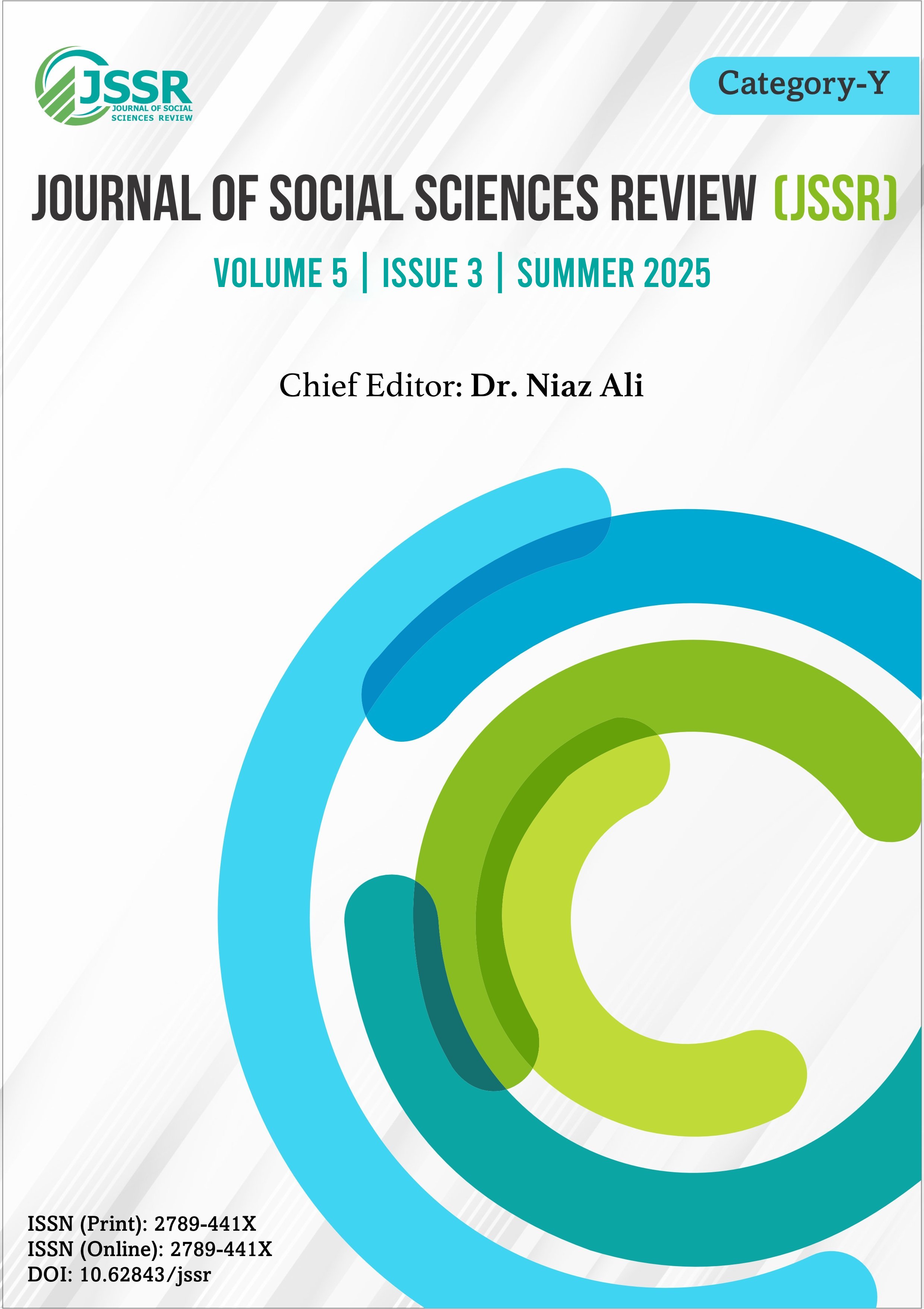A Study of Compound Formation and Semantic Opacity in Punjabi
DOI:
https://doi.org/10.62843/jssr.v5i3.558Keywords:
Punjabi, Derivational Morphology, Compound Formation, Semantic OpacityAbstract
This research aims to investigate how Punjabi compounds are formed and in what way the formation of some of these compounds contributes to semantic opacity. This is qualitative research, where data have been analyzed descriptively. The study identifies and categorizes various types of compounds, including endocentric, exocentric, copulative, and verbal compounds. The study reveals that exocentric compounds are formed without the interfixes and follow patterns such as A+N, N+A, N+V, and A+V patterns. Endocentric compounds are found in N+N, A+N, and N+A combinations. These are found with and without interfixes, though compounding with interfixes is noticed as a rare morphological process in Punjabi. Copulative compounds are observed in N+N, A+A, and V+V patterns. These are also formed without the interfixes. Verbal compounds are seen in N+dv and A+dv. Notably, semantic opacity is found in exocentric and copulative compounds. The research underscores a need for detailed work on semantic opacity in Punjabi compounds.
References
Abbi, A. (1992). Reduplication in South Asian languages: An areal, typological and historical study. New Delhi: Allied Publishers.
Baart, J. L. G. (2006). An introduction to syntax and morphology: A guide for field linguists. SIL International.
Bauer, L. (2003). Introducing linguistic morphology (2nd ed.). Edinburgh University Press.
Bauer, L. (2005). Les composés exocentriques de l’anglais. In D. Amiot (Ed.), La composition dans une perspective typologique (pp. 35–47). Arras: Artois Presses Université.
Benczes, R. (2004). On the analysability of English exocentric compounds. Jezekoslovija, 5(1–2).
Bhatia, T. K. (1993). Punjabi: A Cognitive-descriptive Grammar. Routledge.
Bloomfield, L. (1933). Language. Chicago: University of Chicago Press.
Butt, M., & King, T. H. (2006). The status of case. In V. Dayal & A. Mahajan (Eds.), Clause structure in South Asian languages (pp. 153–198). Springer.
Haspelmath, M., & Sims, A. D. (2010). Understanding morphology (2nd ed.). London: Hodder Education.
Islam, R. A. (2011). The morphology of loanwords in Urdu: The Persian, Arabic and English strand (PhD thesis). School of English Literature, Language & Linguistics, Newcastle University.
Kachru, Y. (1980). Aspects of Hindi Grammar. Manohar.
Lieber, R. (2009). Introducing morphology. Cambridge University Press.
Malik, M. (2006). Punjabi machine transliteration. In Proceedings of the 21st International Conference on Computational Linguistics and 44th Annual Meeting of the ACL (pp. 1137–1144).
Masica, C. P. (1993). The Indo-Aryan languages. Cambridge University Press.
Plag, I. (2002). Word-formation in English. Cambridge University Press.
Pollatsek, A., & Hyönä, J. (2005). The role of semantic transparency in the processing of Finnish compound words. Language and Cognitive Processes, 20(1–2), 261–290. https://doi.org/10.1080/01690960444000098
Scalise, S., & Guevara, E. (2006). Exocentric compounding in a typological framework. Lingue e Linguaggio, 5(2), 185–206. https://doi.org/10.1418/23143
Shackle, C. (2003). Punjabi. In G. Cardona & D. Jain (Eds.), The Indo-Aryan Languages (pp. 581–621). Routledge
Sharma, D. (1998). Word Formation in Hindi: A Study of Compounding. Delhi: Bahri Publications.
Versteegh, K. (2001). Linguistic contacts between Arabic and other languages. Arabica, 48(4), 470–508. https://doi.org/10.1163/157005801323163825
Downloads
Published
Issue
Section
License
Copyright (c) 2025 Copyright in the Journal of Social Sciences Review is retained by the author(s). Authors also grant any third party the right to use the article freely as long as its integrity is maintained and its original authors, citation details and publisher are identified.

This work is licensed under a Creative Commons Attribution-NonCommercial 4.0 International License.
SSR's Editorial Board shares the vision of providing free access to information, education, and science for everyone, thus promoting its content through an OPEN ACCESS POLICY, fulfilling the DOAJ definition of open access. The JSSR adheres to an Open Access and Copyright Licensing Policy based on the belief that making research freely accessible to the public promotes greater global knowledge sharing.
The JSSR uses the Creative Commons Attribution-NonCommercial 4.0 International License. The authors who apply and publish in JSSR consent to abide by the copyright policy set out in the Creative Commons 4.0 license (Attribution-NonCommercial 4.0 International license).
- Copyright in the Journal of Social Sciences Review is retained by the author(s).
- Authors also grant any third party the right to use the article freely as long as its integrity is maintained and its original authors, citation details and publisher are identified.
While "By 'open access' to this literature, we mean its free availability on the public internet, permitting any users to read, download, copy, distribute, print, search, or link to the full texts of these articles, crawl them for indexing, pass them as data to software, or use them for any other lawful purpose, without financial, legal, or technical barriers other than those inseparable from gaining access to the internet itself."



